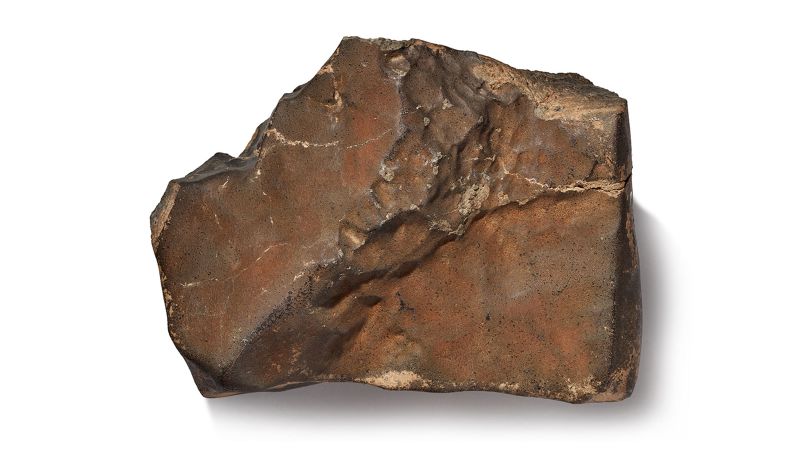In a remarkable auction event at Sotheby’s New York, a meteorite recognized as the largest known piece of Mars on Earth was sold for an astonishing hammer price of $4.3 million. The sale, which occurred on a Wednesday, attracted significant attention primarily because the buyer remains anonymous, adding an element of intrigue to the extraordinary artifact. The meteorite, designated with the nomenclature NWA 16788, weighs a hefty 54 pounds (24.5 kilograms). This weight is particularly notable when considering the usual size of Martian meteorites, which are often small fragments.
Meteorites, in general, are remnants that survive the treacherous journey through Earth’s atmosphere after being ejected from their original celestial bodies, such as comets or asteroids. NWA 16788 was discovered in November 2023, located in the harsh and remote expanse of the Agadez region in Niger. According to Sotheby’s, this meteorite is exceptionally significant, its dimensions being approximately 70% larger than the previous most substantial known piece of Martian rock ever discovered on Earth. The rarity of such specimens cannot be overstated, as only about 400 Martian meteorites are recorded to have been found on Earth so far.
Cassandra Hatton, who holds the position of Vice Chairman of Science and Natural History at Sotheby’s, emphasized the extraordinary nature of NWA 16788. She articulated that it is indeed a monumental specimen, possessing not only immense value but also cultural significance as the most precious Martian meteorite ever placed on auction. Hatton described the meteorite’s journey through space and time, underscoring its unique size and its striking red color — characteristics that render it “a once-in-a-generation find.” The excitement surrounding this meteorite stems not just from its size but from the tangible connection it provides to Mars, a planet that continues to captivate human imagination.
Scientific inquiry into NWA 16788’s internal composition has suggested that it was likely blasted from the Martian surface by a powerful asteroid impact. This cataclysmic event was so intense that it transformed parts of the meteorite into glass. The surface of the meteorite showcases a glassy crust generated as it passed through Earth’s atmosphere, demonstrating the violent journey it undertook before arriving on our planet.
While the auction of such a significant scientific artifact raises eyebrows, some experts have expressed concerns. There are fears that the meteorite could vanish into private collections, possibly never to be accessible for public knowledge or further research. Steve Brusatte, a paleontology and evolution professor at Scotland’s University of Edinburgh, articulated these concerns, insisting that it would be a loss if this extraordinary object were not displayed in a museum where it could educate and inspire the public.
Conversely, viewpoints vary among scientists regarding the implications of the auction. Julia Cartwright, a planetary scientist and part of the Institute for Space/School of Physics & Astronomy at the University of Leicester, suggested that there is indeed a delicate balance to navigate. She noted that the market for meteorites, encompassing searching, collecting, and selling, fuels scientific exploration and discovery, allowing researchers to access an array of materials for study. Cartwright further highlighted that without this market, the scientific community would likely possess far fewer meteorite specimens to analyze.
Interestingly, although NWA 16788’s future remains uncertain, Cartwright mentioned that a reference sample has been preserved at the Purple Mountain Observatory in China, ensuring that part of the meteorite’s scientific value is retained for research purposes. As of now, the interest surrounding NWA 16788 persists, prompting anticipation about its new owner and their potential interest in science.
In a previous auction in February 2021, another Martian meteorite that contained atmospheric samples from Mars itself attracted significant attention, selling for $200,000, exceeding expectations as it was anticipated to fetch between $30,000 and $50,000. Both occurrences reiterate the growing fascination with Martian meteorites, the stories they tell, and their powerful connection to our understanding of the cosmos.












